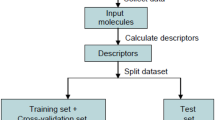Abstract
Polybrominated diphenyl ether congeners (PBDEs) might activate the AhR (aromatic hydrocarbon receptor) signal transduction, and thus might have an adverse effect on the health of humans and wildlife. Because of the limited experimental data, it is important and necessary to develop structure-based models for prediction of the toxicity of the compounds. In this study, a new molecular structure representation, molecular hologram, was employed to investigate the quantitative relationship between toxicity and molecular structures for 18 PBDEs. The model with the significant correlation and robustness (r 2 = 0.991, q 2 LOO = 0.917) was developed. To verify the robustness and prediction capacity of the derived model, 14 PBDEs were randomly selected from the database as the training set, while the rest were used as the test set. The results generated under the same modeling conditions as the optimal model are as follows: r 2 = 0.988, q 2 LOO = 0.598, r 2 pred = 0.955, and RMSE (root-mean-square of errors) = 0.155, suggesting the excellent ability of the derived model to predict the toxicity of PBDEs. Furthermore, the structural features and molecular mechanism related to the toxicity of PBDEs were explored using HQSAR color coding.
Similar content being viewed by others
References
Vives I, Grimalt J O, Lacorte S, Guillamón M, Barceló D. Polybromodiphenyl ether flame retardants in fish from lakes in European high mountains and Greenland. Environ Sci Technol, 2004, 38: 2338–2344
Klasson W E, Hovander L, Bergman Å. New organohalogens in human plasma identification and quantification. Organohalogen Comp, 1997, 33: 420–425
Norén K, Meironyte D. Certain organochlorine and organobromine contaminants in Swedish human milk in perspective of past 20–30 years. Chemosphere, 2000, 40: 1111–1123
Sjädin A, Hagmar L, Klasson-Wehler E, Kronholm-Diab K, Jakobsson E, Bergman A. Flame retardant exposure: Polybrominated diphenyl ethers in blood from Swedish workers. Environ Health Perspect, 1999, 107: 643–648
Tjärnlund U, Ericson G, Örn U, deWit C, Balk L. Effects of two polybrominated diphenyl ethers on rainbow trout (Oncorhynchus mykiss) exposed via food. Marine Environ Res, 1998, 46: 107–112
Okey A B, Riddick D S, Harper P A. The Ah receptor: Mediator of the toxicity of 2,3,7,8-tetrachlorodibenzo-p-dioxin (TCDD) and related compounds. Toxicol Lett, 1994, 70: 1–22
Wang Y W, Liu H X, Zhao C Y, Liu H X, Cai Z W, Jiang G B. Quantitative structure-activity relationship models for prediction of the toxicity of polybrominated diphenyl ether congeners. Environ Sci Technol, 2005, 39: 4961–4966
Wang Y W, Zhao C Y, Ma W P, Liu H X, Wang T, Jiang G B. Quantitative structure-activity relationship for prediction of the toxicity of polybrominated diphenyl ether (PBDE) congeners. Chemosphere, 2006, 64: 515–524
Wang X D, Xiao Q F, Cui S H, Liu S S, Yin D Q, Wang L S. Holographic QSAR of environmental estrogens. Sci China Ser B Chem, 2005, 48: 156–161
Hurst T, Heritage T. HQSAR-A highly predictive QSAR technique based on molecular holograms. In: 213th ACS Natl Meeting. San Francisco, 1997
Lowis D. HQSAR: A New, Highly Predictive QSAR Technique. Tripos Technical Notes. Tripos Inc, 1997
Chen G S, Konstantinov A D, Chittim B G, Joyce E M, Bols N C, Bunce N J. Synthesis of polybrominated diphenyl ethers and their capacity to induce CYP1A by the Ah receptor mediated pathway. Environ Sci Technol, 2001, 35: 3749–3756
Zupan J, Novič M. Optimisation of structure representation for QSAR studies. Anal Chim Acta, 1999, 388: 243–250
Fraschini E, Bonati L, Pitea D. Molecular polarizability as a tool for understanding the binding properties of polychlorinated dibenzo-p-dioxins: Definition of a reliable computational procedure. J Phys Chem, 1996, 100: 10564–10569
Bonati L, Fraschini E, Lasagni M, Modoni E P, Pitea D. A hypothesis on the mechanism of PCDD biological activity based on molecular electrostatic potential modeling. Part 2. J Mol Struct (THEOCHEM), 1995, 340: 83–95
Tuppurainen K, Ruuskanen J. Electronic eigenvalue (EEVA): A new QSAR/QSPR descriptor for electronic substituent effects based on molecular orbital energies. A QSAR approach to the Ah receptor binding affinity of polychlorinated biphenyls (PCBs), dibenzo-pdioxins (PCDDs) and dibenzofurans (PCDFs). Chemosphere, 2000, 41: 843–848
Author information
Authors and Affiliations
Corresponding authors
Additional information
Supported by the Key Project of the National Natural Science Foundation of China (Grant No. 20737001), the National Natural Science Foundation Key Project of China (Grant No. 20737001) and the Science and Technology Development Foundation Project of Nanjing Medical University (Grant No. 06NMUM021)
Rights and permissions
About this article
Cite this article
Yang, X., Wang, X., Zhang, Y. et al. Holographic quantitative structure-activity relationship for prediction of the toxicity of polybrominated diphenyl ether congeners. Sci. China Ser. B-Chem. 52, 2342–2350 (2009). https://doi.org/10.1007/s11426-009-0167-z
Received:
Accepted:
Published:
Issue Date:
DOI: https://doi.org/10.1007/s11426-009-0167-z




